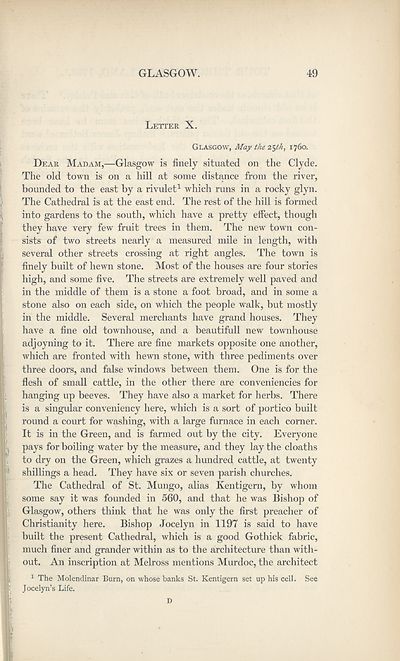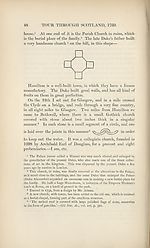Series 1 > Tours in Scotland 1747, 1750, 1760
(136) Page 49
Download files
Complete book:
Individual page:
Thumbnail gallery: Grid view | List view

GLASGOW.
49
Letter X.
Glasgow, May the 25th, 1760.
Dear Madam,—Glasgow is finely situated on the Clyde.
The old town is on a hill at some distance from the river,
bounded to the east by a rivulet1 which runs in a rocky glyn.
The Cathedral is at the east end. The rest of the hill is formed
into gardens to the south, which have a pretty effect, though
they have very few fruit trees in them. The new town con¬
sists of two streets nearly a measured mile in length, with
several other streets crossing at right angles. The town is
finely built of hewn stone. Most of the houses are four stories
high, and some five. The streets are extremely well paved and
in the middle of them is a stone a foot broad, and in some a
stone also on each side, on which the people walk, but mostly
in the middle. Several merchants have grand houses. They
have a fine old townhouse, and a beautifull new townhouse
adjoyning to it. There are fine markets opposite one another,
which are fronted with hewn stone, with three pediments over
three doors, and false windows between them. One is for the
flesh of small cattle, in the other there are conveniencies for
hanging up beeves. They have also a market for herbs. There
is a singular conveniency here, which is a sort of portico built
round a court for washing, with a large furnace in each corner.
It is in the Green, and is farmed out by the city. Everyone
pays for boiling water by the measure, and they lay the cloaths
to dry on the Green, which grazes a hundred cattle, at twenty
shillings a head. They have six or seven parish churches.
The Cathedral of St. Mungo, alias Kentigern, by whom
some say it was founded in 560, and that he was Bishop of
Glasgow, others think that he was only the first preacher of
Christianity here. Bishop Jocelyn in 1197 is said to have
built the present Cathedral, which is a good Gothick fabric,
much finer and grander within as to the architecture than with¬
out. An inscription at Melross mentions Murdoc, the architect
1 The Molendinar Burn, on whose banks St. Kentigern set up his cell. See
Jocelyn’s Life.
D
49
Letter X.
Glasgow, May the 25th, 1760.
Dear Madam,—Glasgow is finely situated on the Clyde.
The old town is on a hill at some distance from the river,
bounded to the east by a rivulet1 which runs in a rocky glyn.
The Cathedral is at the east end. The rest of the hill is formed
into gardens to the south, which have a pretty effect, though
they have very few fruit trees in them. The new town con¬
sists of two streets nearly a measured mile in length, with
several other streets crossing at right angles. The town is
finely built of hewn stone. Most of the houses are four stories
high, and some five. The streets are extremely well paved and
in the middle of them is a stone a foot broad, and in some a
stone also on each side, on which the people walk, but mostly
in the middle. Several merchants have grand houses. They
have a fine old townhouse, and a beautifull new townhouse
adjoyning to it. There are fine markets opposite one another,
which are fronted with hewn stone, with three pediments over
three doors, and false windows between them. One is for the
flesh of small cattle, in the other there are conveniencies for
hanging up beeves. They have also a market for herbs. There
is a singular conveniency here, which is a sort of portico built
round a court for washing, with a large furnace in each corner.
It is in the Green, and is farmed out by the city. Everyone
pays for boiling water by the measure, and they lay the cloaths
to dry on the Green, which grazes a hundred cattle, at twenty
shillings a head. They have six or seven parish churches.
The Cathedral of St. Mungo, alias Kentigern, by whom
some say it was founded in 560, and that he was Bishop of
Glasgow, others think that he was only the first preacher of
Christianity here. Bishop Jocelyn in 1197 is said to have
built the present Cathedral, which is a good Gothick fabric,
much finer and grander within as to the architecture than with¬
out. An inscription at Melross mentions Murdoc, the architect
1 The Molendinar Burn, on whose banks St. Kentigern set up his cell. See
Jocelyn’s Life.
D
Set display mode to:
![]() Universal Viewer |
Universal Viewer | ![]() Mirador |
Large image | Transcription
Mirador |
Large image | Transcription
Images and transcriptions on this page, including medium image downloads, may be used under the Creative Commons Attribution 4.0 International Licence unless otherwise stated. ![]()
| Scottish History Society volumes > Series 1 > Tours in Scotland 1747, 1750, 1760 > (136) Page 49 |
|---|
| Permanent URL | https://digital.nls.uk/126604389 |
|---|
| Attribution and copyright: |
|
|---|
| Description | Over 180 volumes, published by the Scottish History Society, containing original sources on Scotland's history and people. With a wide range of subjects, the books collectively cover all periods from the 12th to 20th centuries, and reflect changing trends in Scottish history. Sources are accompanied by scholarly interpretation, references and bibliographies. Volumes are usually published annually, and more digitised volumes will be added as they become available. |
|---|


